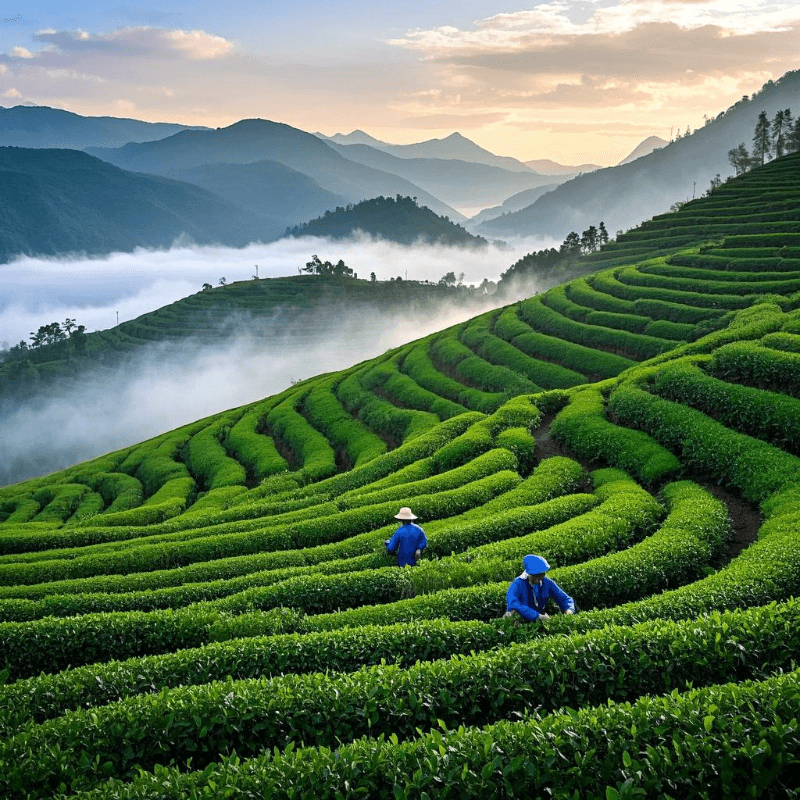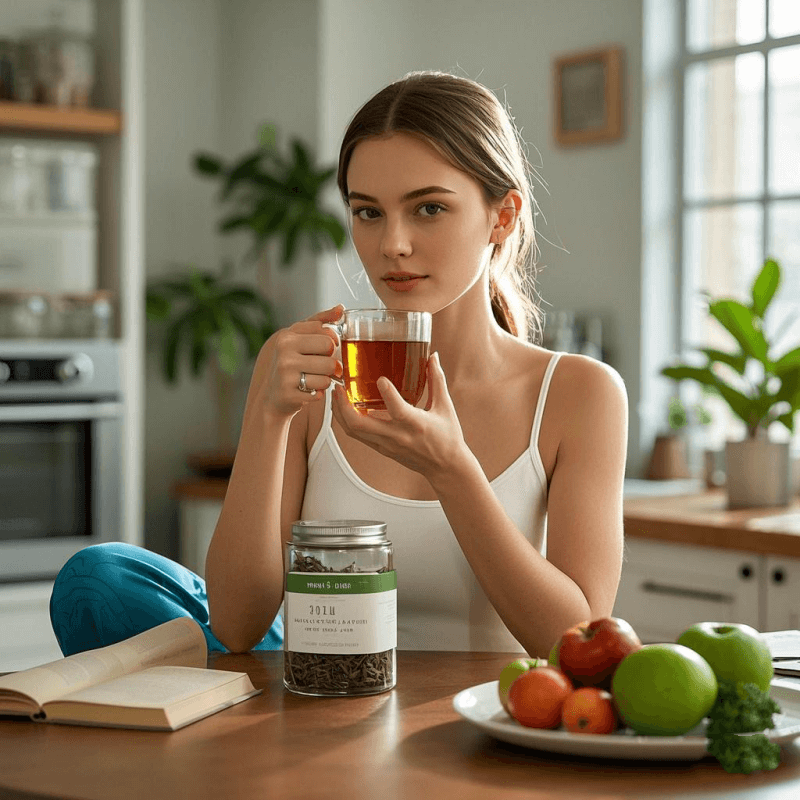
In the pantheon of premium oolong teas, Tieguanyin—often called the “Iron Goddess of Mercy”—stands as a paragon of flavor and tradition. This celebrated brew from China’s Fujian Province has captivated tea enthusiasts for centuries with its complex aroma, smooth taste, and deep cultural roots. But what makes Tieguanyin oolong tea more than just a beverage? It’s a sensory journey that blends agricultural artistry, spiritual symbolism, and unparalleled taste.
This guide unlocks the mysteries of Tieguanyin oolong tea, exploring its origins, flavor profile, brewing rituals, and health benefits. Whether you’re a seasoned connoisseur or new to oolong tea, prepare to discover why this iconic Chinese oolong has earned its place among the world’s most revered brews.
1. Introduction: Why Tieguanyin Oolong Tea Deserves Your Attention
The first sip of authentic Tieguanyin oolong tea reveals why it’s cherished by generations. Unlike generic oolong tea, Tieguanyin offers a unique balance of floral brightness and creamy depth, a result of its meticulous production in the mist-shrouded mountains of Anxi County. But its allure extends beyond taste: each cup carries the weight of a 200-year-old tradition, making it a cultural artifact as much as a beverage.
As tea sommelier Michael Wang notes, “Tieguanyin is not just drunk; it’s experienced. The way its aroma evolves over steeps, the story behind its name—every aspect invites you to slow down and appreciate the craft.” For those seeking more than a caffeine fix, Tieguanyin oolong tea offers a gateway to understanding Chinese tea culture in its purest form.
2. What Is Tieguanyin Tea? Origins and Naming Significance
Tieguanyin oolong tea traces its roots to the 19th century in Anxi, Fujian, where legend says a farmer discovered the tea plant near a Tieguanyin (Goddess of Mercy) temple. The name “Iron Goddess of Mercy” (铁观音) reflects both the dark, iron-like appearance of the leaves and the spiritual significance of the discovery.
The Legend of Its Discovery
According to local lore:
- A poor farmer, Wang Libang, prayed daily at a Tieguanyin temple.
- One night, the goddess appeared to him in a dream, guiding him to a tea plant.
- He cultivated the plant, and its leaves produced an extraordinary tea that brought prosperity.
- Out of gratitude, he named the tea after the goddess, Tieguanyin.
Modern Production in Anxi
Today, Anxi remains the epicenter of Tieguanyin production, with strict geographical indications protecting its authenticity. The tea is made from the Camellia sinensis var. tieguanyin plant, which thrives in Anxi’s acidic soil and misty climate. Producers follow traditional methods:
- Hand-picking leaves during the spring or autumn harvest
- Sun-withering to reduce moisture
- Oxidizing 20–30% (for traditional styles) or less (for modern “green” styles)
- Charcoal-roasting to develop flavor
3. Unique Flavor and Aroma Profile of Tieguanyin Oolong Tea
The flavor of Tieguanyin oolong tea is a masterclass in balance, with regional variations and production methods creating distinct profiles:
Traditional vs. Modern Styles
- Traditional Tieguanyin:
- Oxidation: 20–30%, often charcoal-roasted
- Aroma: Toasted nuts, caramel, and baked fruit
- Taste: Smooth, with notes of roasted chestnut and a honeyed finish
- Example: Anxi traditional Tieguanyin from Teavivre
- Modern “Green” Tieguanyin:
- Oxidation: 10–15%, minimally roasted
- Aroma: Intense orchid, jasmine, and green apple
- Taste: Bright and crisp, with a vegetal freshness and lingering floral sweetness
- Example: Anxi high-mountain Tieguanyin
Sensory Experience Breakdown
- Dry Leaves: Tight, dark green curls with a glossy sheen, releasing a subtle floral-nutty aroma
- Brewed Color: Golden-yellow to amber, depending on roast level
- Mouthfeel: Creamy and smooth, with a “thick” texture that coats the palate
- Aftertaste: A refreshing sweetness that lingers, often described as “mouthwatering”
Taster’s Note: “The first steep hits you with orchid notes, then gives way to a creamy mid-palate. The finish is like biting into a ripe pear—clean and sweet,” says tea blogger Emma Chen in her review of Anxi Tieguanyin.
4. Cultural Heritage: The Story Behind This Famous Chinese Oolong
Tieguanyin oolong tea is deeply intertwined with Chinese culture, from religious rituals to artistic expression:
Tea Ceremonies and Rituals
- Gongfu Cha: Tieguanyin is a staple in the Chinese tea ceremony, where its multiple steeps (5–7 times) allow participants to observe flavor transformations.
- Festival Offerings: During the Qingming Festival, Tieguanyin is often placed as an offering to ancestors, symbolizing respect and continuity.
Art and Literature
- Poets in the Qing Dynasty praised Tieguanyin’s “heavenly fragrance,” comparing its aroma to celestial flowers.
- Modern artists like calligrapher Zhang Wei have created works inspired by the tea’s name, blending characters for “iron,” “goddess,” and “tea.”
Global Cultural Impact
- Taiwanese Adaptations: When Fujianese immigrants brought Tieguanyin to Taiwan, they developed high-mountain variations, like Alishan Tieguanyin, which (blend) local terroir with ancestral techniques.
- Western Appreciation: In the 21st century, Tieguanyin oolong tea has gained popularity in Western tea circles, with sommeliers highlighting its versatility in cocktail pairings and culinary applications.
5. How to Brew Tieguanyin Oolong Tea for the Best Experience
Brewing Tieguanyin oolong tea is an art that requires precision to unlock its full potential:
Essential Tools
- Gaiwan: Traditional lidded bowl for gongfu brewing
- Yixing Clay Pot: Absorbs flavors over time, ideal for aged Tieguanyin
- Tea Strainer: To catch small leaves
- Fair Cup: Ensures uniform steeping
Step-by-Step Brewing Guide
- Water Temperature:
- Traditional roasted Tieguanyin: 195–205°F (90–96°C)
- Modern green Tieguanyin: 175–185°F (79–85°C)
- Leaf-to-Water Ratio:
- 5–6g (1 tsp) per 6 oz (180ml) of water
- Steeping Technique:
- Rinse: Quick 5-second rinse with hot water to wake the leaves
- First Steep: 20–30 seconds for bright flavor
- Subsequent Steeps: Add 10 seconds each time, up to 7 steeps
- Pro Tip: For roasted styles, preheat the gaiwan with hot water to enhance aroma
Gongfu Brewing Ritual
Follow these steps for an authentic experience:
- Warm teaware with hot water
- Add tea leaves to the gaiwan (“dry fragrance” step)
- Inhale the dry leaf aroma before rinsing
- Pour brewed tea into a fair cup, then distribute to tiny cups
- Sip slowly, focusing on aroma and aftertaste
Expert Insight: “Tieguanyin rewards patience. The third steep is often where its complexity truly emerges,” says Master Tea Brewer Li Jianwei. Elevate your tea experience with authentic oolong teaware designed for this precise brewing method.
6. Top Benefits of Drinking Tieguanyin Oolong Tea

Beyond its cultural and sensory appeal, Tieguanyin oolong tea offers notable health benefits:
Antioxidant-Rich Profile
- Contains high levels of catechins (e.g., EGCG) and theaflavins, which fight free radicals. A 2018 study in Phytomedicine found Tieguanyin’s antioxidant activity rivals that of blueberries.
Metabolism Support
- Caffeine and EGCG in Tieguanyin oolong tea may boost metabolism. A 2009 study showed daily consumption could increase fat oxidation by 12–15%.
Heart Health
- Regular drinking may lower LDL cholesterol and improve blood pressure. A meta-analysis in Journal of Functional Foods linked oolong tea to a 7–10% reduction in cardiovascular risk factors.
Mental Clarity
- L-theanine in oolong tea promotes calm focus, while moderate caffeine (30–50mg/cup) enhances alertness without jitters.
Hydration with Benefits
- Unlike sugary drinks, Tieguanyin provides hydration plus potential dental benefits from its fluoride content.
7. Conclusion: Celebrate Tradition and Taste with Tieguanyin Oolong
From its mythical origins in Anxi to its status as a global tea icon, Tieguanyin oolong tea is a testament to the power of tradition and craftsmanship. Each cup is a bridge between the past and present, offering a sensory experience that honors centuries of tea mastery.
Whether you’re drawn to its orchid-scented modern iterations or the roasted depth of traditional styles, Tieguanyin oolong tea invites you to slow down and savor life’s simple pleasures. Discover the subtle beauty of oolong tea with our premium leaves, sourced from Anxi’s finest gardens to ensure authenticity and quality.
As you brew your next cup, remember: you’re not just drinking tea—you’re partaking in a living tradition. Let the Iron Goddess of Mercy guide your palate, and may each sip reveal new layers of flavor and appreciation.

Pingback: Da Hong Pao Oolong Tea: Uncover Bold Flavors & Imperial Tales